#John Joseph Mathews
Photo
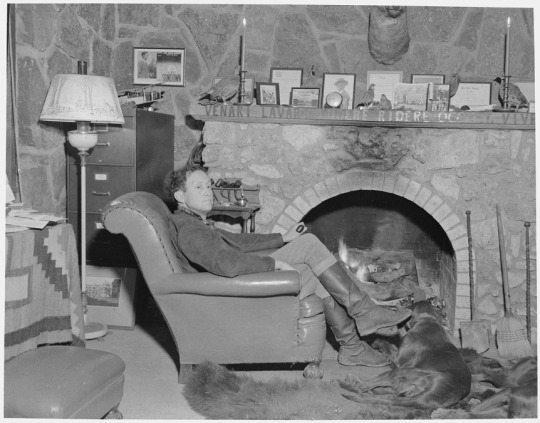
John Joseph Mathews, Osage Council Member, author, historian, and Rhodes Scholar, seated at home in front of his fireplace, Oklahoma, 12/16/1937.
Record Group 75: Records of the Bureau of Indian Affairs
Series: General Photographs of Indians
Image description: Mr. Mathews sits in an armchair in front of a fireplace, with a dog at his feet. The fireplace and walls are made of stone. Next to the fireplace is a table with smoking pipes on it, and a filing cabinet; on the wall is a framed cover of Mathews’ book SUNDOWN. The mantelpiece has candles, framed photos and certificates, and taxidermied animals. The mantel bears the Latin words VENARI LAVARI LUDERE RIDERE OCCAST VIVERE (To hunt, to bathe, to play, to laugh, is to live).
#archivesgov#December 16#1937#1930s#John Joseph Mathews#Osage Nation#Native American history#Indigenous American history#American Indian history#authors#Oklahoma#fireplace#cozy#dog
42 notes
·
View notes
Text
Show me a motherfucker with big brown eyes and I’m automatically whipped
#the brown is the most essential part#pedro pascal#brian quinn#alex brightman#keanu reeves#john boyega#david tennant#joe mazzello#jordan fisher#ryan guzman#joe keery#joseph quinn#anirudh pisharody#bruce campbell#elliot knight#mathew baynton#dominic sessa#miles teller#dev patel#big brown eyes#brown eyes#ej waffles#nonsense by ej#middle of the night thoughts#more from the drafts
3K notes
·
View notes
Text
Full crew list! With names, ranks, and ages! (tho some have less detailed portraits since they've only really shown up in the background at this point). I'll update periodically with better pics.
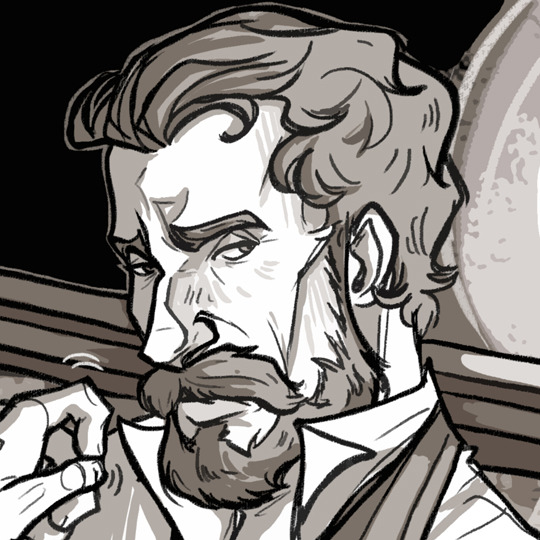
Name: Barzillai Waite
Rank: Captain
Age: 46

Name: Adelaide Waite
Rank: Captain's wife
Age: 34

Name: Eric Mathews
Rank: 1st mate
Age: 32

Name: Ezra Carter
Rank: 2nd mate
Age: 25

Name: Charles Allen
Rank: 3rd mate
Age: 34
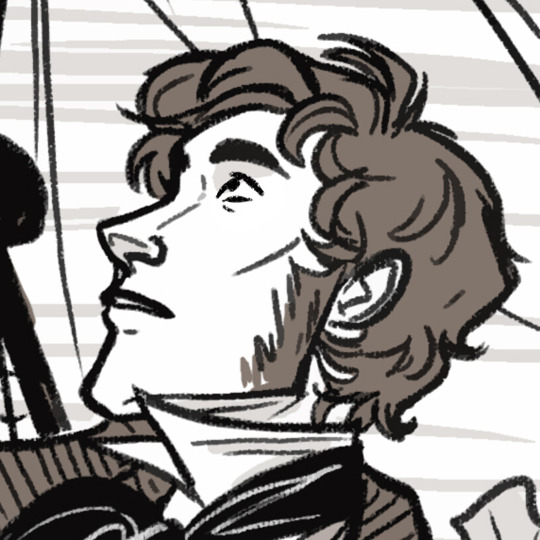
Name: Lawrence Manner
Rank: Greenhand
Age: 26

Name: Josué Cabral
Rank: Ordinary
Age: 22
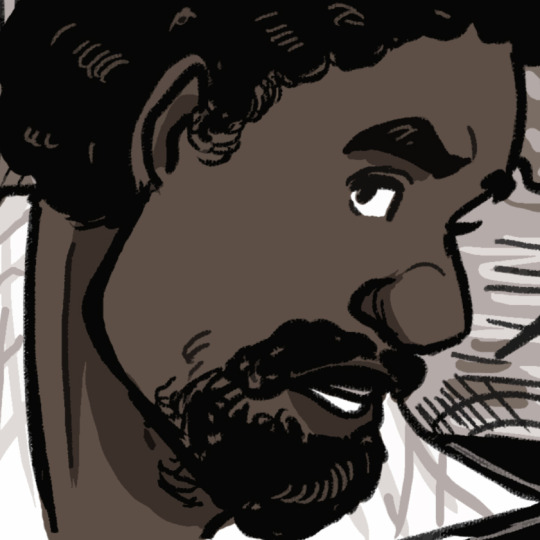
Name: Bastien Addo
Rank: Ordinary
Age: 28
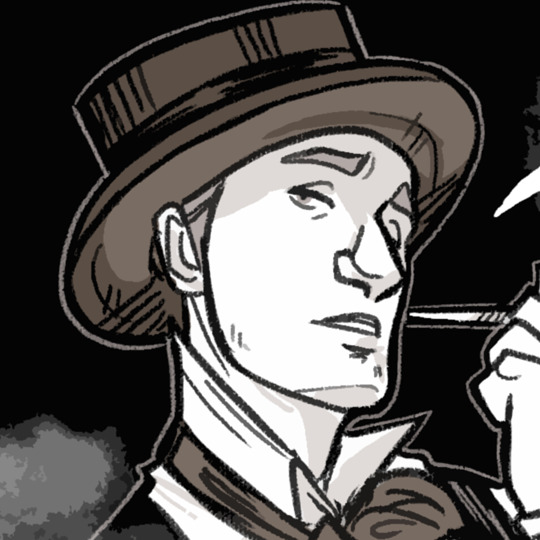
Name: James Barnard
Rank: Ordinary
Age: 29

Name: Joseph O'Reilly
Rank: Ordinary
Age: 23

Name: Jackson Pells
Rank: Greenhand
Age: 17

Name: Silas Dickey
Rank: Greenhand
Age: 16

Name: Enoch Pike
Rank: Cooper and Carpenter
Age: 32

Name: Abnur Wright
Rank: Ordinary
Age: 20

Name: Luis Sela
Rank: Ordinary
Age: 21

Name: Samuel Nelson
Rank: Greenhand
Age: 21

Name: William Williams
Rank: Boatsteerer
Age: 27

Name: Frank Iona
Rank: Greenhand
Age: 19

Name: Francis Goldwhit
Rank: Boatsteerer
Age: 23

Name: Martin Amos
Rank: Boatsteerer
Age: 27

Name: João de Silva
Rank: Boatsteerer
Age: 24
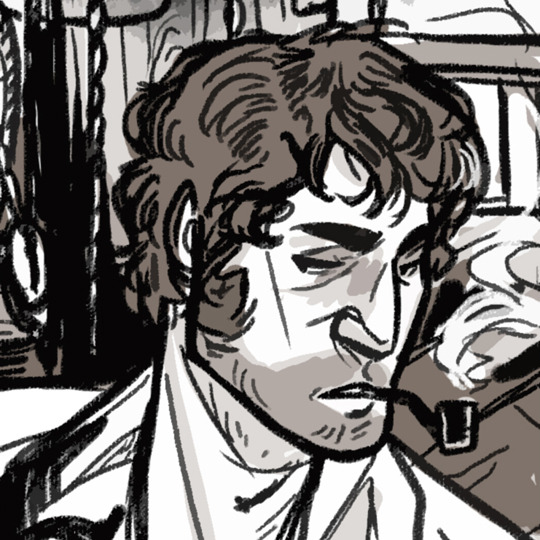
Name: George Lee
Rank: Ordinary
Age: 26

Name: Ephraim Murray
Rank: Cook
Age: 41
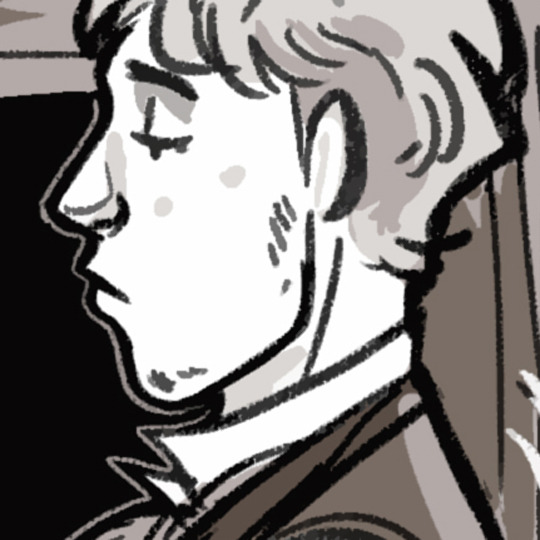
Name: John Gillipse
Rank: Steward
Age: 18
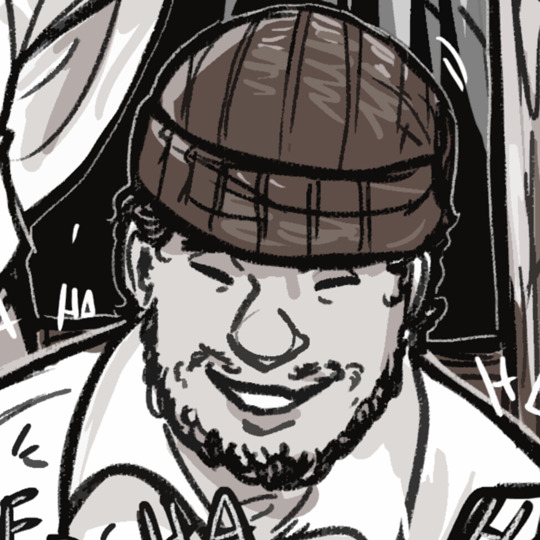
Name: Apollo Delaman
Rank: Ordinary
Age: 21
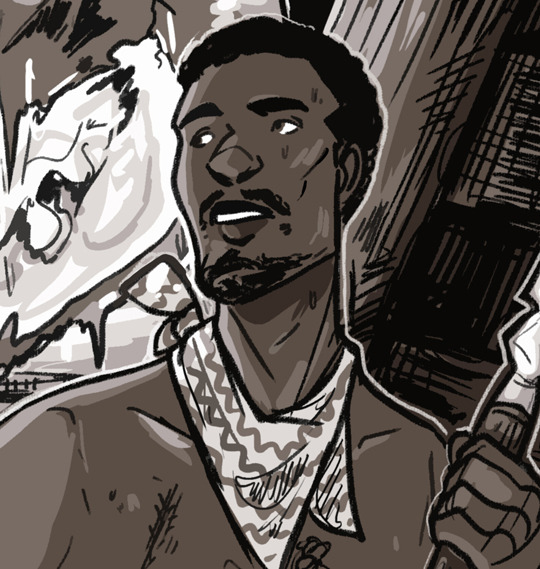
Name: Peter Fortune
Rank: Ordinary
Age: 28

Name: Afonso Borges
Rank: Greenhand
Age: 23
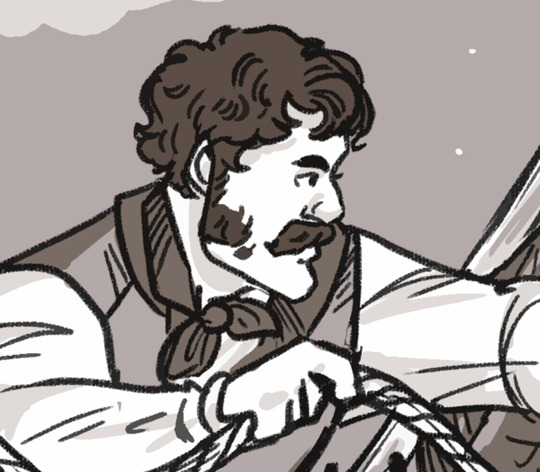
Name: Ed Barker
Rank: Ordinary
Age: 25

Name: Josiah Ripley
Rank: Ordinary
Age: 23
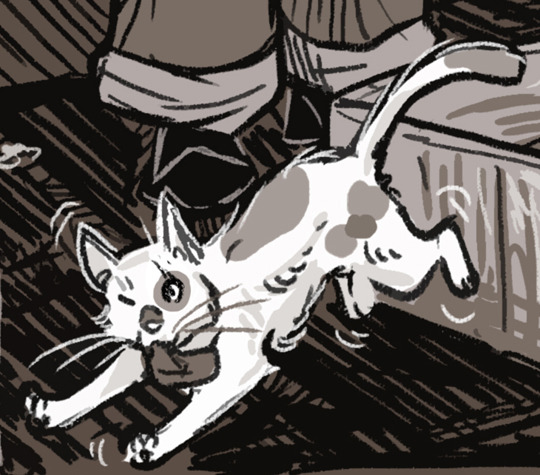
Name: Scupper
Rank: Mouser extraordinaire
Age: 3
124 notes
·
View notes
Text
full list of biden letter 2:
Aaron Bay-Schuck
Aaron Sorkin
Adam & Jackie Sandler
Adam Goodman
Adam Levine
Alan Grubman
Alex Aja
Alex Edelman
Alexandra Shiva
Ali Wentworth
Alison Statter
Allan Loeb
Alona Tal
Amy Chozick
Amy Pascal
Amy Schumer
Amy Sherman Palladino
Andrew Singer
Andy Cohen
Angela Robinson
Anthony Russo
Antonio Campos
Ari Dayan
Ari Greenburg
Arik Kneller
Aron Coleite
Ashley Levinson
Asif Satchu
Aubrey Plaza
Barbara Hershey
Barry Diller
Barry Levinson
Barry Rosenstein
Beau Flynn
Behati Prinsloo
Bella Thorne
Ben Stiller
Ben Turner
Ben Winston
Ben Younger
Billy Crystal
Blair Kohan
Bob Odenkirk
Bobbi Brown
Bobby Kotick
Brad Falchuk
Brad Slater
Bradley Cooper
Bradley Fischer
Brett Gelman
Brian Grazer
Bridget Everett
Brooke Shields
Bruna Papandrea
Cameron Curtis
Casey Neistat
Cazzie David
Charles Roven
Chelsea Handler
Chloe Fineman
Chris Fischer
Chris Jericho
Chris Rock
Christian Carino
Cindi Berger
Claire Coffee
Colleen Camp
Constance Wu
Courteney Cox
Craig Silverstein
Dame Maureen Lipman
Dan Aloni
Dan Rosenweig
Dana Goldberg
Dana Klein
Daniel Palladino
Danielle Bernstein
Danny Cohen
Danny Strong
Daphne Kastner
David Alan Grier
David Baddiel
David Bernad
David Chang
David Ellison
David Geffen
David Gilmour &
David Goodman
David Joseph
David Kohan
David Lowery
David Oyelowo
David Schwimmer
Dawn Porter
Dean Cain
Deborah Lee Furness
Deborah Snyder
Debra Messing
Diane Von Furstenberg
Donny Deutsch
Doug Liman
Douglas Chabbott
Eddy Kitsis
Edgar Ramirez
Eli Roth
Elisabeth Shue
Elizabeth Himelstein
Embeth Davidtz
Emma Seligman
Emmanuelle Chriqui
Eric Andre
Erik Feig
Erin Foster
Eugene Levy
Evan Jonigkeit
Evan Winiker
Ewan McGregor
Francis Benhamou
Francis Lawrence
Fred Raskin
Gabe Turner
Gail Berman
Gal Gadot
Gary Barber
Gene Stupinski
Genevieve Angelson
Gideon Raff
Gina Gershon
Grant Singer
Greg Berlanti
Guy Nattiv
Guy Oseary
Gwyneth Paltrow
Hannah Fidell
Hannah Graf
Harlan Coben
Harold Brown
Harvey Keitel
Henrietta Conrad
Henry Winkler
Holland Taylor
Howard Gordon
Iain Morris
Imran Ahmed
Inbar Lavi
Isla Fisher
Jack Black
Jackie Sandler
Jake Graf
Jake Kasdan
James Brolin
James Corden
Jamie Ray Newman
Jaron Varsano
Jason Biggs & Jenny Mollen Biggs
Jason Blum
Jason Fuchs
Jason Reitman
Jason Segel
Jason Sudeikis
JD Lifshitz
Jeff Goldblum
Jeff Rake
Jen Joel
Jeremy Piven
Jerry Seinfeld
Jesse Itzler
Jesse Plemons
Jesse Sisgold
Jessica Biel
Jessica Elbaum
Jessica Seinfeld
Jill Littman
Jimmy Carr
Jody Gerson
Joe Hipps
Joe Quinn
Joe Russo
Joe Tippett
Joel Fields
Joey King
John Landgraf
John Slattery
Jon Bernthal
Jon Glickman
Jon Hamm
Jon Liebman
Jonathan Baruch
Jonathan Groff
Jonathan Marc Sherman
Jonathan Ross
Jonathan Steinberg
Jonathan Tisch
Jonathan Tropper
Jordan Peele
Josh Brolin
Josh Charles
Josh Goldstine
Josh Greenstein
Josh Grode
Judd Apatow
Judge Judy Sheindlin
Julia Garner
Julia Lester
Julianna Margulies
Julie Greenwald
Julie Rudd
Juliette Lewis
Justin Theroux
Justin Timberlake
Karen Pollock
Karlie Kloss
Katy Perry
Kelley Lynch
Kevin Kane
Kevin Zegers
Kirsten Dunst
Kitao Sakurai
KJ Steinberg
Kristen Schaal
Kristin Chenoweth
Lana Del Rey
Laura Dern
Laura Pradelska
Lauren Schuker Blum
Laurence Mark
Laurie David
Lea Michele
Lee Eisenberg
Leo Pearlman
Leslie Siebert
Liev Schreiber
Limor Gott
Lina Esco
Liz Garbus
Lizanne Rosenstein
Lizzie Tisch
Lorraine Schwartz
Lynn Harris
Lyor Cohen
Madonna
Mandana Dayani
Mara Buxbaum
Marc Webb
Marco Perego
Maria Dizzia
Mark Feuerstein
Mark Foster
Mark Scheinberg
Mark Shedletsky
Martin Short
Mary Elizabeth Winstead
Mathew Rosengart
Matt Lucas
Matt Miller
Matthew Bronfman
Matthew Hiltzik
Matthew Weiner
Matti Leshem
Max Mutchnik
Maya Lasry
Meaghan Oppenheimer
Melissa Zukerman
Michael Aloni
Michael Ellenberg
Michael Green
Michael Rapino
Michael Rappaport
Michael Weber
Michelle Williams
Mike Medavoy
Mila Kunis
Mimi Leder
Modi Wiczyk
Molly Shannon
Nancy Josephson
Natasha Leggero
Neil Blair
Neil Druckmann
Nicola Peltz
Nicole Avant
Nina Jacobson
Noa Kirel
Noa Tishby
Noah Oppenheim
Noah Schnapp
Noreena Hertz
Odeya Rush
Olivia Wilde
Oran Zegman
Orlando Bloom
Pasha Kovalev
Pattie LuPone
Paul & Julie Rudd
Paul Haas
Paul Pflug
Peter Traugott
Polly Sampson
Rachel Riley
Rafi Marmor
Ram Bergman
Raphael Margulies
Rebecca Angelo
Rebecca Mall
Regina Spektor
Reinaldo Marcus Green
Rich Statter
Richard Jenkins
Richard Kind
Rick Hoffman
Rick Rosen
Rita Ora
Rob Rinder
Robert Newman
Roger Birnbaum
Roger Green
Rosie O’Donnell
Ross Duffer
Ryan Feldman
Sacha Baron Cohen
Sam Levinson
Sam Trammell
Sara Foster
Sarah Baker
Sarah Bremner
Sarah Cooper
Sarah Paulson
Sarah Treem
Scott Braun
Scott Braun
Scott Neustadter
Scott Tenley
Sean Combs
Seth Meyers
Seth Oster
Shannon Watts
Shari Redstone
Sharon Jackson
Sharon Stone
Shauna Perlman
Shawn Levy
Sheila Nevins
Shira Haas
Simon Sebag Montefiore
Simon Tikhman
Skylar Astin
Stacey Snider
Stephen Fry
Steve Agee
Steve Rifkind
Sting & Trudie Styler
Susanna Felleman
Susie Arons
Taika Waititi
Thomas Kail
Tiffany Haddish
Todd Lieberman
Todd Moscowitz
Todd Waldman
Tom Freston
Tom Werner
Tomer Capone
Tracy Ann Oberman
Trudie Styler
Tyler James Williams
Tyler Perry
Vanessa Bayer
Veronica Grazer
Veronica Smiley
Whitney Wolfe Herd
Will Ferrell
Will Graham
Yamanieka Saunders
Yariv Milchan
Ynon Kreiz
Zack Snyder
Zoe Saldana
Zoey Deutch
Zosia Mamet
14 notes
·
View notes
Text
who i write for ‣ dmercer91

‣ the anaheim ducks!
trevor zegras
john gibson
‣ the new jersey devils!
nico hischier
luke hughes
jack hughes
dawson mercer
seamus casey*
‣ the vancouver canucks!
quinn hughes
cole mcward*
brock boeser
‣ the toronto maple leafs!
matthew knies
mitch marner
joseph woll
william nylander
simon benoit
connor dewar
‣ the carolina hurricanes!
frederik andersen
pyotr kochetkov
‣ the florida panthers!
matthew tkachuk
mackie samoskevich*
‣ the columbus blue jackets!
adam fantilli
‣ the new york islanders!
mathew barzal
‣ the chicago blackhawks!
kevin korchinski
‣ the philadelphia flyers
jamie drysdale
‣ the dallas stars !
wyatt johnston
thomas harley
tyler seguin
‣ utah hc !
john marino
‣ the michigan wolverines! (ncaa)
mark estapa
luca fantilli
ethan edwards
rutger mcgroarty
nick moldenhauer
23 notes
·
View notes
Text
i went to a used book sale today... procured:
railroad color history: new york central railroad (brian solomon & mike schafer) — i'm not actually that into trains but it appealed to me.
the complete guide to the soviet union (jennifer louis & victor louis) — travel guide from 1980
an anthology including the big sleep (raymond chandler), "the undignified melodrama of the bone of contention" (dorothy l. sayers), "the arrow of god" (leslie charteris), "i can find my way out" (ngaio marsh), instead of evidence (rex stout), "rift in the loot" (stuart palmer & craig rice), "the man who explained miracles" (john dickson carr), & rebecca (daphne du maurier) (i already have this one..) — it's volume 2 of something (a treasury of great mysteries) which annoys me but whatever
an anthology including "godmother tea" (selena anderson), "the apartment" (t. c. boyle), "a faithful but melancholy account of several barbarities lately committed" (jason brown), "sibling rivalry" (michael byers), "the nanny" (emma cline), "halloween" (mariah crotty), "something street" (carolyn ferrell), "this is pleasure" (mary gaitskill), "in the event" (meng jin), "the children" (andrea lee), "rubberdust" (sarah thankam mathews), "it's not you" (elizabeth mccracken), "liberté" (scott nandelson), "howl palace" (leigh newman), "the nine-tailed fox explains" (jane pek), "the hands of dirty children" (alejandro puyana), "octopus vii" (anna reeser), "enlightenment" (william pei shih), "kennedy" (kevin wilson), & "the special world" (tiphanie yanique) — i guess they're all short stories published in 2020 by usamerican/canadian authors
an anthology including the death of ivan ilyich (leo tolstoy) (i have already read this one..), the beast in the jungle (henry james), heart of darkness (joseph conrad), seven who were hanged (leonid andreyev), abel sánchez (miguel de unamuno), the pastoral symphony (andré gide), mario and the magician (thomas mann), the old man (william faulkner), the stranger (albert camus), & agostino (alberto moravia)
the ambassadors (henry james)
the world book desk reference set: book of nations — it's from 1983 so this is kind of a history book...
yet another fiction anthology......... including the general's ring (selma lagerlöf), "mowgli's brothers" (rudyard kipling), "the gift of the magi" (o. henry) (i have already read this one..), "lord mountdrago" (w. somerset maugham), "music on the muscatatuck" (jessamyn west), "the pacing goose" (jessamyn west), "the birds" (daphne du maurier), "the man who lived four thousand years" (alexandre dumas), "the pope's mule" (alphonse daudet), "the story of the late mr. elvesham" (h. g. wells), "the blue cross" (g. k. chesterton), portrait of jennie (robert nathan), "la grande bretèche" (honoré de balzac), "love's conundrum" (anthony hope), "the great stone face" (nathaniel hawthorne), "germelshausen" (friedrich gerstäcker), "i am born" (charles dickens), "the legend of sleepy hollow" (washington irving), "the age of miracles" (melville davisson post), "the long rifle" (stewart edward white), "the fall of the house of usher" (edgar allan poe) (i have already read this one..), the voice of bugle ann (mackinlay kantor), the bridge of san luis rey (thornton wilder), "basquerie" (eleanor mercein kelly), "judith" (a. e. coppard), "a mother in mannville" (marjorie kinnan rawlings), "kerfol" (edith wharton), "the last leaf" (o. henry), "the bloodhound" (arthur train), "what the old man does is always right" (hans christian anderson), the sea of grass (conrad richter), "the sire de malétroit's door" (robert louis stevenson), "the necklace" (guy de maupassant) (i have already read this one..), "by the waters of babylon" (stephen vincent benét), a. v. laider (max beerbohm), "the pillar of fire" (percival wilde), "the strange will" (edmond about), "the hand at the window" (emily brontë) (i have already read this one..), & "national velvet" (enid bagnold) — why are seven of these chapters of novels....? anyway fun fact one of the compilers here also worked on the aforementioned mystery anthology. also anyway Why did i bother to write all that ☹️
fundamental problems of marxism (georgi plekhanov) — book about dialectical/historical materialism which is published here as the first volume of something (marxist library) which is kind of odd to me tbh
one last (thankfully tiny) anthology including le père goriot (honoré de balzac) & eugénie grandet (honoré de balzac)
6 notes
·
View notes
Text
Squash's Book Roundup 2023
Last year I read 67 books. This year my goal was 70, but I very quickly passed that, so in total I read 92 books this year. Honestly I have no idea how I did it, it just sort of happened. My other goal was to read an equal amount of fiction and nonfiction this year (usually fiction dominates), and I was successful in that as well. Another goal which I didn’t have at the outset but which kind of organically happened after the first month or so of reading was that I wanted to read mostly strange/experimental/transgressive/unusual fiction. My nonfiction choices were just whatever looked interesting or cool, but I also organically developed a goal of reading a wider spread of subjects/genres of nonfiction. A lot of the books I read this year were books I’d never heard of, but stumbled across at work. Also, finally more than 1/3 of what I read was published in the 21st century.
I’ll do superlatives and commentary at the end, so here is what I read in 2023:
-The Commitments by Roddy Doyle
-A Simple Story: The Last Malambo by Leila Guerriero
-The Hero With A Thousand Faces by Joseph Campbell
-Uzumaki by Junji Ito
-Chroma by Derek Jarman
-The Emerald Mile: The epic story of the fastest ride in history through the Grand Canyon by Kevin Fedarko
-Venus by Suzan-Lori Parks
-The Hearing Trumpet by Leonora Carrington
-Sacred Sex: Erotic writings from the religions of the world by Robert Bates
-The Virginia State Colony For Epileptics And The Feebleminded by Molly McCully Brown
-A Spy In The House Of Love by Anais Nin
-The Sober Truth: Debunking the bad science behind 12-step programs and the rehab industry by Lance Dodes
-The Sailor Who Fell From Grace With The Sea by Yukio Mishima
-The Aliens by Annie Baker
-The Criminal Child And Other Essays by Jean Genet
-Aimee and Jaguar: A Love Story, Berlin 1943 by Erica Fischer
-The Master And Margarita by Mikhail Bulgakov
-The Mustache by Emmanuel Carriere
-Maldoror by Comte de Lautreamont
-Narrow Rooms by James Purdy
-At Your Own Risk by Derek Jarman
-Escape From Freedom by Erich Fromm
-Countdown: A Subterranean Magazine #3 by Underground Press Syndicate Collective
-Fabulosa! The story of Britain's secret gay language by Paul Baker
-The Golden Spruce: A true story of myth, madness and greed by John Vaillant
-Querelle de Roberval by Kevin Lambert
-Fire The Bastards! by Jack Green
-Closer by Dennis Cooper
-The Woman In The Dunes by Kobo Abe
-Opium: A Diary Of His Cure by Jean Cocteau
-Worker-Student Action Committees France May '68 by Fredy Perlman and R. Gregoire
-Capitalist Realism by Mark Fisher
-The Sound Of Waves by Yukio Mishima
-One Day In My Life by Bobby Sands
-Corydon by Andre Gide
-Noopiming by Leanne Betasamosake Simpson
-Man Alive: A true story of violence, forgiveness and becoming a man by Thomas Page McBee
-The Artist's Reality: Philosophies of Art by Mark Rothko
-Damage by Josephine Hart
-Schoolgirl by Osamu Dazai
-The Passion According to G.H. by Clarice Lispector
-The Sex Revolts: Gender, Rebellion and Rock n Roll by Simon Reynolds and Joy Press
-The Traffic Power Structure by planka.nu
-Bird Man: The many faces of Robert Straud by Jolene Babyak
-Seven Dada Manifestos by Tristan Tzara
-The Journalist by Harry Mathews
-Bullshit Jobs by David Graeber
-Moscow To The End Of The Line by Venedikt Erofeev
-Morvern Callar by Alan Warner
-The Poetics Of Space by Gaston Bachelard
-A Boy's Own Story by Edmund White
-The Coming Insurrection by The Invisible Committee
-Jesus' Son by Denis Johnson
-Notes From The Sick Room by Steve Finbow
-Artaud The Momo by Antonin Artaud
-Doctor Rat by William Kotzwinkle
-Recollections Of A Part-Time Lady by Minette
-trans girl suicide museum by Hannah Baer
-The 99% Invisible City by Roman Mars
-Sweet Days Of Discipline by Fleur Jaeggy
-Breath: The new science of a lost art by James Nestor
-What We See When We Read by Peter Mendelsund
-The Cardiff Tapes (1972) by Garth Evans
-The Ark Sakura by Kobo Abe
-Mad Like Artaud by Sylvere Lotringer
-The Story Of The Eye by Georges Bataille
-Little Blue Encyclopedia (For Vivian) by Hazel Jane Plante
-Blood And Guts In High School by Kathy Acker
-Summer Fun by Jeanne Thornton
-Splendid's by Jean Genet
-VAS: An Opera In Flatland by Steve Tomasula
-Sorry I'm Late, I Didn't Want To Come: One introvert's year of saying yes by Jessica Pan
-Whores For Gloria by William T. Vollmann
-The Notebooks by Jean-Michel Basquiat, Larry Walsh (editor)
-L'Astragale by Albertine Sarrazin
-The Decay Of Lying and other essays by Oscar Wilde
-The Immortal Life Of Henrietta Lacks by Rebecca Skloot
-Open Throat by Henry Hoke
-Prisoner Of Love by Jean Genet
-The Fifth Wound by Aurora Mattia
-The Communist Manifesto by Karl Marx
-My Friend Anna: The true story of a fake heiress by Rachel DeLoache Williams
-Mammother by Zachary Schomburg
-Building The Commune: Radical democracy in Venezuela by George Cicarello-Maher
-Blackouts by Justin Torres
-Cheapjack by Philip Allingham
-Near To The Wild Heart by Clarice Lispector
-The Trayvon Generation by Elizabeth Alexander
-Skye Papers by Jamika Ajalon
-Exercises In Style by Raymon Queneau
-Tender Buttons by Gertrude Stein
-The Feather Thief: Beauty, Obsession, and the Natural History Heist of the Century by Kirk Wallace Johnson
~Some number factoids~
I read 46 fiction and 46 nonfiction. One book, The Fifth Wound by Aurora Mattia, is fictionalized/embellished autobiography, so it could go half in each category if we wanted to do that, but I put it in the fiction category.
I tried to read as large a variety of nonfiction subjects/genres as I could. A lot of the nonfiction I read has overlapping subjects, so I’ve chosen to sort by the one that seems the most overarching. By subject, I read: 5 art history/criticism, 5 biographies, 1 black studies, 1 drug memoir, 2 essay collections, 2 history, 2 Latin American studies, 4 literary criticism, 1 music history, 2 mythology/religion, 1 nature, 4 political science, 2 psychology, 5 queer studies, 2 science, 1 sociology, 1 travel, 2 true crime, 3 urban planning.
I also read more queer books in general (fiction and nonfiction) than I have in years, coming in at 20 books.
The rest of my commentary and thoughts under a cut because it's fairly long
Here’s a photo of all the books I read that I own a physical copy of (minus Closer by Dennis Cooper which a friend is borrowing):

~Superlatives and Thoughts~
I read so many books this year I’m going to do a runner-up for each superlative category.
Favorite book: This is such a hard question this year. I think I gave out more five-star ratings on Goodreads this year than I ever have before. The books that got 5 stars from me this year were A Simple Story: The Last Malambo by Leila Guerriero, Capitalist Realism by Mark Fisher, The Emerald Mile by Kevin Fedarko, The Mustache by Emmanuel Carriere, The Passion According to GH by Clarice Lispector, trans girl suicide museum by Hannah Baer, The Fifth Wound by Aurora Mattia, Mammother by Zachary Schomburg, and Blackouts by Justin Torres.
But I think my favorite book of the year was The Fifth Wound by Aurora Mattia. It is an embellished, fictionalized biography of the author’s life, chronicling a breakup that occurred just before she began her transition, and then a variety of emotional events afterward and her renewal of a connection with that person after a number of years had passed. The writing style is beautiful, extremely decadent, and sits in a sort of venn diagram of poetry, theory, fantasy and biography. My coworker who recommended this book to me said no one she’d recommended it to had finished it because they found it so weird. I read the first 14 pages very slowly because I didn’t exactly know what the book was doing, but I quickly fell completely in love with the imagery and the formatting style and the literary and religious references that have been worked into the book both as touchstones for biography and as vehicles for fantasy. There is a video I remember first seeing years ago, in which a beautiful pinkish corn snake slithers along a hoop that is part of a hanging mobile made of driftwood and macrame and white beads and prism crystals. This was the image that was in the back of my head the entire time I was reading The Fifth Wound, because it matched the decadence and the strangeness and the crystalline beauty of the language and visuals in the book. It is a pretty intense book, absolutely packed with images and emotion and ideas and preserved vignettes where reality and fantasy and theory overlap. It’s one of those books that’s hard to describe because it’s so full. It’s dense not in that the words or ideas are hard to understand, but in that it’s overflowing with imagery and feelings, and it feels like an overflowing treasure chest.
Runner-up:The Mustache by Emmanuel Carriere. However, this book wins for a different superlative, so I’ve written more about it there.
Least favorite book: Querelle de Roberval by Kevin Lambert. I wrote a whole long review of it. In summary, Lambert’s book takes its name from Querelle de Brest, a novel by Jean Genet, and is apparently meant to be an homage to Genet’s work. Unfortunately, Lambert seems to misunderstand or ignore all the important aspects of Genet’s work that make it so compelling, and instead twists certain motifs Genet uses as symbols of love or transcendence into meaningless or negative connotations. He also attempts to use Genet’s mechanic of inserting the author into the narrative and allowing the author to have questionable or conflicting morals in order to emphasize certain aspects of the characters or narrative, except he does so too late in the game and ends up just completely undermining everything he writes. This book made me feel insulted on behalf of Jean Genet and all the philosophical thought he put into his work.
Runner-up: What We See When We Read by Peter Mendelsund. This graphic designer claims that when people read they don’t actually imagine what characters look like and can’t conjure up an image in their head when asked something like “What does Jane Eyre look like to you?” Unfortunately, there’s nothing scientific in the book to back this up and it’s mostly “I” statements, so it’s more like “What Peter Mendelsund Sees (Or Doesn’t See) When He Reads”. It’s written in what seems to be an attempt to mimic Marshall McLuhan’s style in The Medium Is The Massage, but it isn’t done very well. I spent most of my time reading this book thinking This does not reflect my experience when I read novels so I think really it’s just a bad book written by someone who maybe has some level of aphantasia or maybe is a visual but not literary person, and who assumes everyone else experiences the same thing when they read.
(Another runner-up would be The Hero With A Thousand Faces by Joseph Campbell, but I think that’s a given because it’s an awful piece of revisionist, racist trash, so I won’t write a whole thing about it. I can if someone wants me to.)
Most surprising/unexpected book: The Mustache by Emmanuel Carriere. This book absolutely wins for most surprising. However, I don’t want to say too much about it because the biggest surprise is the end. It was the most shocking, most unexpected and bizarre endings to a novel I’ve read in a long time, and I absolutely loved it. It was weird from the start and it just kept getting weirder. The unnamed narrator decides, as a joke, to shave off the moustache he’s had for his entire adult life. When his wife doesn’t react, he assumes that she’s escalating their already-established tradition of little pranks between each other. But then their mutual friends say nothing about the change, and neither do his coworkers, and he starts spiral into confusion and paranoia. I don’t want to spoil anything else because this book absolutely blew me away with its weirdness and its existential dread and anyone who likes weird books should read it.
Runner-up: Morvern Callar by Alan Warner. I don’t even know what compelled me to open this book at work, but I’m glad I did. The book opens on Christmas, where the main character, Morvern, discovers her boyfriend dead by suicide on the kitchen floor of their flat. Instead of calling the police or her family, she takes a shower, gets her things and leaves for work. Her narrative style is strange, simultaneously very detached and extremely emotional, but emotional in an abstract way, in which descriptions and words come out stilted or strangely constructed. The book becomes a narrative of Morvern’s attempts to find solitude and happiness, from the wilderness of Scotland to late night raves and beaches in an unnamed Mediterranean city. The entire book is scaffolded by a built-in playlist. Morvern’s narrative is punctuated throughout by accounts of exactly what she’s listening to on her Walkman. The narrative style and the playlist and the bizarre behavior of the main character were not at all what I was expecting when I opened the book, but I read the entire book in about 3 hours and I was captivated the whole time. If you like the Trainspotting series of books, I would recommend this one for sure.
Most fun book: The Emerald Mile by Kevin Fedarko. This book was amazing. It was like reading an adventure novel and a thriller and a book on conservationism all wrapped into one and it was clearly very passionately written and it was a blast. I picked it up because I was pricing it at work and I read the captions on one of the photo inserts, which intrigued me, so I read the first page, and then I couldn’t stop. The two main narratives in the book are the history of the Grand Canyon (more specifically the damming of the Colorado River) and the story of a Grand Canyon river guide called Kenton Grua, who decided with two of his river guide friends to break the world record for fastest boat ride down the Colorado River through the Grand Canyon. The book is thoroughly researched, and reaches back to the first written record of the canyon, then charts the history of the canyon and the river up to 1983 when Grua made his attempt to race down the river, and then the aftermath and what has happened to everyone in the years since. All of the historical figures as well as the “current” figures of 1983 come to life, and are passionately portrayed. It’s a genuine adventure of a book, and I highly recommend it.
Runner-up: Summer Fun by Jeanne Thornton. It asks “What if Brian Wilson of the Beach Boys was actually a trans woman?” Actually, that’s not quite it. It asks “What if a trans woman living in poverty in southwest America believed to an almost spiritual level that Brian Wilson was a trans woman?” The main character and narrator, Gala, is convinced that the lead singer of her favorite band, the Get Happies, (a fictional but fairly obvious parallel to the Beach Boys) is a trans woman. Half the book is her writing out her version of the singer’s life history, and the other half is her life working at a hostel in Truth Or Consequences, New Mexico, where she meets a woman who forces her out of her comfort zone and encourages her to face certain aspects of her self and identity and her connection with others. It’s a weird novel, and definitely not for everyone, but it’s fun. I was reading it on the train home and I was so into it that I missed my stop and had to get off at the next station and wait 20 minutes for the train going back the other way.
Book that taught me the most: Breath: The new science of a lost art by James Nestor. In it, Nestor explores why humans as a general population are so bad at breathing properly. He interviews scientists and alternative/traditional health experts, archaeologists, historians and religious scholars. He uses himself as a guinea pig to experiment with different breathing techniques from ancient meditation styles to essentially overdosing on oxygen in a lab-controlled environment to literally plugging his nose shut to only mouth-breathe for two weeks (and then vice-versa with nose breathing). It was interesting to see a bunch of different theories a laid out together regarding what kind of breathing is best, as well as various theories on the history of human physiology and why breathing is hard. Some of it is scientific, some pseudoscience, some just ancient meditation techniques, but he takes a crack at them all. What was kind of cool is that he tries every theory and experiment with equal enthusiasm and doesn’t really seem to favor any one method. Since he’s experimenting on himself, a lot of it is about the effects the experiments had on him specifically and his experiences with different types of breathing. His major emphasis/takeaway is that focusing on breathing and learning to change the ways in which we breathe will be beneficial in the long run (and that we should all breath through our noses more). While I don’t think changing how you breathe is a cure-all (some of the pseudoscience he looks at in this book claims so) I certainly agree that learning how to breath better is a positive goal.
Runner-up: The Sober Truth by Lance Dodes. I say runner-up because a lot of the content of the book is things that I had sort of vague assumptions about based on my knowledge of addiction and AA and mental illness in general. But Dodes put into words and illustrated with numbers and anecdotes and case studies what I just kind of had a vague feeling about. It was cool to see AA so thoroughly debunked by an actual psychiatrist and in such a methodical way, since my skepticism about it has mostly been based on the experiences of people I know in real life, anecdotes I’ve read online, or musicians/writers/etc I’m a fan of that went through it and were negatively affected.
Most interesting/thought provoking book: Mammother by Zachary Schomburg. The biggest reason this book was so interesting is because the little world in which it exists is so strange and yet so utterly complete. In a town called Pie Time (where birds don’t exist and the main form of work is at the beer-and-cigarettes factory) a young boy called Mano who has been living his childhood as a girl decides that he is now a man and that it’s time for him to grow up. As this happens, the town is struck by an affliction called God’s Finger. People die seemingly out of nowhere, from a hole in their chest, and some object comes out of the hole. Mano collects the things that come out of these holes, and literally holds them in order to love them, but the more he collects, the bigger he becomes as he adds objects to his body. A capitalist business called XO shows up, trying to convince the people of Pie Time that they can protect themselves from God’s Finger with a number of enterprises, and starts to slowly take over the town. But Mano doesn’t believe death is something that should be run from. This book is so pretty, and the symbolism/metaphors, even when obvious, feel as though they belong organically in the world. A quote on the back of the book says it is “as nearly complete a world as can be”, and I think that’s a very accurate description. The story is interesting, the characters are compelling, and the magical realist world in which the story exists is fascinating.
Runner up: trans girl suicide museum by Hannah Baer. This is a series of essays taken (for the most part) from Baer’s blog posts. They span a chunk of time in which she writes her thoughts and musings on her experience transition and transgender existence in general. It is mostly a series of pieces reflecting on “early” stages of transition. But I thought it was really cool to see an intellectual and somewhat philosophical take on transition, written by someone who has only been publicly out for a few years, and therefore is looking at certain experiences with a fresh gaze. As the title suggests, a lot of the book is a bit sad, but it’s not all doom and gloom. A lot of the emphasis is on the important of community when it comes to the experience of starting to transition and the first few years, and the importance of community on the trans experience in general. I really liked reading Hannah Baer’s thoughts as a queer intellectual who was writing about this stuff as she experienced it (or not too long after) rather than writing about the experience of early transition years and years down the line. It meant the writing was very sharp and the emotion was clear and not clouded by nostalgia.
Other thoughts/commentary on books I don’t have superlatives for:
I’m glad my first (full) book read in 2023 was A Simple Story: The Last Malambo by Leila Guierrero. It’s a small, compact gem of a book that follows the winner of an Argentinian dance competition. The Malambo is a traditional dance, and the competition is very fierce, and once someone wins, they can never compete again. The author follows the runner-up of the previous year, who has come to compete again. It paints a vivid picture of the history of the dance, the culture of the competition, and the character of the dancer the author has chosen to follow. It’s very narrowly focused, which makes it really compelling.
The Hearing Trumpet by Leonora Carrington could have easily won for most fun or most interesting book. Carrington was a surrealist writer and painter (and was in a relationship with Max Ernst until she was institutionalized and he was deported by the Nazis). In The Hearing Trumpet, an elderly woman called Marian is forced by her family to go live in an old ladies’ home. The first strange thing about the place is that all of the little cabins each woman lives in is shaped like some odd object, like an iron, or ice cream, or a rabbit. The other old women at the institution are a mixed bag, and the warden of the place is hostile. Marian starts to suspect that there are secrets, and even witchcraft involved, and she and a few of the other ladies start to try and unravel the occult mysteries hidden in the grounds of the home. The whole book is fun and strange, and the ending is an extremely entertaining display of feminist occult surrealism.
Sacred Sex: Erotica writings from the religions of the world by Robert Bates was a book I had to read for research for my debunking of Withdrawn Traces. It was really very interesting, but it was also hilarious to read because maybe 5% of any of the texts included were actually erotic. It should have been called “romantic writings from the religions of the world” because so little of the writing had anything to do with sex, even in a more metaphorical sense.
Every time I read Yukio Mishima I’m reminded how much I love his style. The Sailor Who Fell From Grace With The Sea almost usurped The Temple of the Golden Pavilion as my favorite Mishima novel. I’m fascinated with the way that Mishima uses his characters to explore the circumstance of having very intense feelings or reactions towards something and simultaneously wanting to experience that, while also wanting to have complete control and not feel them at all. There’s a scene in this novel where Noboru and his friends brutally kill and dissect a cat; it’s an intense and vividly rendered scene, made all the more intense by Noboru desperately conflicted between feeling affected by the killing and wanting to force himself to feel nothing. The amazing subtle theme running through the book is the difference between Noboru’s intense emotions and his desire/struggle to control them and subdue them versus Ryuji’s more subtle emotion that grows through the book despite his natural reserve. I love endings like the one in this book, where it “cuts to black” and you don’t actually see the final act, it’s simply implied.
In 2016 or 2017, I ran lights for a showcase for the drama department at UPS (I can’t remember now what it was) that included a bunch of scenes from various plays. I remember a segment from Hir by Taylor Mac, and a scene from The Aliens by Annie Baker. In the scene that I saw, one of the characters describes how when he was a boy, he couldn’t stop saying the word ladder, and the monologue culminates in a full paragraph that is just the word “ladder.” I can’t remember who was acting in the one that I saw at UPS, but that monologue blew me away, the way that one word repeated 127 conveyed so much. This year a collection of Annie Baker’s plays came in at work so I sat down and read the whole play and it was just incredible. I’d love to see the full play live, it’s absolutely captivating.
Narrow Rooms by James Purdy was a total diamond in the rough. It takes place in Appalachia, in perhaps the 1950s although it’s somewhat hard to tell. It follows the strange gay entanglement between four adult men in their 20s, who have known each other all their lives. It traces threads of bizarre codependency, and the lines crossed between love and hate. The main character, Sidney, has just returned home after serving a sentence for manslaughter. On his return, he finds that an old lover has been rendered disabled in an accident, and that an old school rival/object of obsession has been waiting for him. This rival, nicknamed “The Renderer” because of an old family occupation, has been watching Sidney all their lives. Both of them hate the other, but know that they’re destined to meet in some way. Caught in the middle of their strange relationship are Gareth, Sidney’s now-disabled former lover, and Brian, a young man who thinks he’s in love with The Renderer. The writing style took me some time to get used to, as it is written as though by someone who has taught themselves, or has only had basic classes on fiction writing. But the plot itself is so strange and the characters are so stilted in their own internality that it actually fits really well. Like The Mustache, this book had one of the strangest, most intensely visceral and shocking endings I’ve read in a while. It was also “one that got away.” I read it at work, then put it on my staff picks shelf, and only realized after someone else bought it that I should have kept it for myself.
The Passion According to G.H. by Clarice Lispector blew my mind. I really don’t want to spoil any of it, but I highly encourage anyone who hasn’t read it to do. The build in tension is perfect and last 30 pages are just incredible. Lispector’s style is so unique and so beautiful and tosses out huge existential questions like it’s nothing, and I love her work so much.
Moscow To The End Of The Line by Venedikt Erofeev was another really unexpected book. It’s extremely Russian (obviously) and really fun until suddenly it isn’t. The main character, a drunkard, gets on a train from Moscow to Petushki, the town at the end of the line (hence the title), in order to see his lover. On the way, he befriends the other people in his train car and they all steadily get drunker and drunker, until he falls asleep and misses his stop. Very Russian, somewhat strange, and I was surprised that it was written in the late 60s and not the 30s.
Dr. Rat by William Kotzwinkle was what I expected. Weird in a goofy way, a bit silly even when it’s serious, and rather heavy-handed satire. The titular Dr Rat is a rat who has spent his whole life in a laboratory and has gone insane. The other animals who are being tested on want to escape, but he’s convinced that all the testing is for the good of science and wants to thwart their rebellion. Unfortunately, all the other animals who are victims of human cruelty/callousness/invasion/deforestation/etc around the world are also planning to rebel, connection with each other through a sort of psychic television network. It’s a very heavy-handed environmentalist/anti-animal cruelty metaphor and general societal satire, but it’s silly and fun too.
Confessions Of A Part-Time Lady by Minette is a self-published, nearly impossible to find book that came into my work. It’s self-printed and bound, and was published in the 70s. It is the autobiographical narrative of a trans woman who did drag and burlesque and theatre work all across the midwest, as well as New York and San Francisco, from the 1930s up to the late 60s. It was originally a series of interviews by the two editors, who published it in narrative form, and it includes photos from Minette’s personal collection. It’s an amazing story, and a glimpse into a really unique time period of gender performance and queer life. She even mentions Sylvia Rivera, specifically when talking about gay activism. She talks about how the original group of the Gay Liberation Front was an eclectic mix of all sorts of people of all sexualities and genders and expressions. Then when the Gay Activists Alliance “took over”, they started pushing out people who were queer in a more transgressive or unusual way and there was more encouragement on being more heteronormative. She mentions Sylvia Rivera and Marsha P Johnson, saying “I remember Sylvia Rivera who founded STAR – Street Transvestite Action Revolutionaries. She was always trying to say things – the same kinds of things Marsha P Johnson says in a sweeter way – and they treated her like garbage. If that’s what ‘order’ is, haven’t we had enough?”
Whores For Gloria by William T Vollmann was exactly as amazing as I thought it would be. I love Vollmann’s style, because you can tell that even though the characters he’s writing about are characters, they’re absolutely based on people that he met or saw or spoke to in real life. The main character, Jimmy, is searching for his former lover, Gloria, who has either died or left him (it is unclear for most of the novel). He begins to use tokens bought from sex workers (hair, clothes, etc) to attempt to conjure her into reality, and when that doesn’t work, he pays them to tell him stories from their lives, and through their lives he tries to conjure Gloria. This novel’s ending had extremely similar vibes to the ending of Moscow To The End Of The Line.
Prisoner Of Love by Jean Genet was a lot to take in. It was weird reading it at this moment in time, and completely unplanned. It’s just that I have only a few more books to read before I’ve made my way through all Genet’s works that have been translated into English, and it was next on the list. Most of the book focuses on Genet’s time spent in Palestine in the 70s and his short return in the 80s. He also discusses the time he spent with the Black Panthers in the US, although it’s not the main subject of the book. Viewing Palestine from the point of view of Genet’s weird philosophical and moral worldview was really interesting, because what he chooses to spend time looking at or talking about is probably not what most would focus on, and because even his most political discussions are tinged with the uniquely Genet-style spirituality (if you can call it that? I don’t know what to call it) that is so much the exact opposite of objective. It’s definitely not a book about Palestine I would recommend reading without also having a grasp of Genet’s style of looking at the world and his various obsessions and preoccupations, because they really do inform a lot of his commentary. It was also written 15 years after his first trip to Palestine, partly from memory and partly from journal entries/notes, which gives it a sort of weirdly dreamlike quality much like his novels.
Blackouts by Justin Torres was so amazing! It blends real life and fiction together so well that I didn’t even realize that most of the people he references in the novel are real historical figures until he mentioned Ben Reitman, who I recognized as the Chicago King Of The Hobos and Emma Goldman’s lover. The book follows an unnamed narrator who has come to a hotel or apartment in the southwest in order to care for a dying elderly man called Juan Gay. Juan has a book called Sex Variants, a study of homosexuality from the 1940s which has been censored and blacked out. Back and forth, the narrator and Juan trade stories. The narrator tells his life story up until the present, including his first meeting with Juan in a mental hospital as a teenager. In turn, Juan tells the story of the Sex Variants book and its creator, Jan Gay (Ben Reitman’s real life daughter). The book explores the reliability of narrative, the power of collecting and documenting life stories, and of removing or changing things in order to create new or different narratives.
Again, Clarice Lispector rocking my world! Generally I can read a 200-ish page novel in somewhere between 2 and 4 hours depending on the content/writing style. Near To The Wild Heart took me 9 hours to read because I kept wanting to stop and reread entire paragraphs because they were so interesting or pretty or philosophical. The story focuses on Joana, whose strange way of looking at the world and going through life makes everyone sort of wary of her. This book is so layered I don’t really know how to describe it. So much of it is philosophical or existential musings through the vehicle of Joana. Unsurprisingly, it’s a beautiful book and I highly recommend it.
I’m just going to copy/paste my Goodreads review for Skye Papers by Jamika Ajalon: This book had so much potential that just…fell short. I could tell that it was written for an American audience but the way the reader/Skye is “taught” certain British terms and/or slang felt a bit patronizing. The characters were fleshed out and interesting and I liked them a lot but the plot crumbled quickly in the last half of the book Things sped up to a degree that felt strange and unnatural, the book’s pacing was inconsistent throughout. Perhaps that was deliberate considering the reveal at the climax, but if it was, it should have been utilized better. If the inconsistent pacing wasn’t deliberate, then it just made the book feel strange to read. There were moments were I felt like there should have been more fleshing out of certain character relationships. Even with the reveal at the end and the explanation of Pieces’ erratic/avoidant behavior, I wish there had been more fleshing out of the relationship or friendship between her and Skye at the beginning, when Skye first arrives in London. Characters who seemed cool/interesting got glossed over and instead there was a lot more dwelling on Skye walking around or busking or just hanging out. I could have gone without the last 30 or so pages after the big reveal, where Skye went back through everything that happened with the knowledge she (and the reader) had gained. It dragged on and on and at that point I felt like the whole story was so contrived that I just wasn’t interested anymore. A friend who read this book before I did said she thought it was an experimental novel that just hadn’t gone far enough, and I completely agree with her. I think if the style with the film script interludes went further, into printed visuals or more weirdness with the interludes, more experimental style with the main story, or something, it would have been really good. It just didn’t push hard enough.
The Feather Thief by Kirk Wallace Johnson was a fun little true crime novel about a young flautist who broke into a small English natural history museum in 2009 and stole hundreds of thousands of pounds worth of preserved rare bird skins dating back to the 19th century. He was a salmon fly-tying enthusiast and prodigy, and old Victorian fly designs used feathers of rare birds. The book first goes through the heist and the judicial proceedings, then examines the niche culture of Victorian fly-tying enthusiasts and obsessives, and then chronicles the author’s attempts to track down some of the missing birds. It was a quick, easy read, but fun and an unusual subject and I quite enjoyed it.
In 2024 I don’t plan on trying to surpass or even reach this year’s number. I’m going to start off the year reading The Recognitions by William Gaddis, then I’m going to re-read a number of books that I come across at work or in conversation and think Huh, I should reread that one of these days. So far, the books I am currently planning to reread: Sometimes A Great Notion by Ken Kesey, As I Lay Dying by William Faulkner, The People Of Paper by Salvador Plascencia, Mrs Dalloway by Virginia Woolf, The Mustache by Emmanuel Carriere, McGlue by Otessa Moshfegh, Long Day’s Journey Into Night by Eugene O’Neil, Acid Snow by Larry Mitchell, and Nightwood by Djuna Barnes.
#reading list#book list#book roundup#reading list year in review#books#squash rambles#reading year in review#book list roundup
6 notes
·
View notes
Text
SPOOKIES (1986) – Episode 257 – Decades Of Horror 1980s
“We almost got our tuchus plunged!” Almost? Shoot, that would’ve made a perfect scene to go with the farting Muck Men. Join your faithful Grue Crew – Crystal Cleveland, Chad Hunt, Bill Mulligan, and Jeff Mohr – as they discuss Spookies (1986)! Wait. Why haven’t we seen this before?
Decades of Horror 1980s
Episode 257 – Spookies (1986)
Join the Crew on the Gruesome Magazine YouTube channel!
Subscribe today! Click the alert to get notified of new content!
https://youtube.com/gruesomemagazine
Gruesome Magazine is partnering with the WICKED HORROR TV CHANNEL (https://wickedhorrortv.com/) which now includes video episodes of Decades of Horror 1980s and is available on Roku, AppleTV, Amazon FireTV, AndroidTV, and its online website across all OTT platforms, as well as mobile, tablet, and desktop.
(It was going to be) A group of teens go to an abandoned house to party and do battle with spirits and creatures they accidentally release from a strange Ouija board. (Instead, it became) A wicked sorcerer tries to sacrifice a group of people inside his house to use their vitality to keep his wife alive.
Directed by: Thomas Doran & Brendan Faulkner (footage from Twisted Souls); Genie Joseph (as Eugenie Joseph);
Writing Credits: Thomas Doran, Frank M. Farel, & Brendan Faulkner (Twisted Souls footage screenplay); Ann Burgund (additional material) (credited as Joseph Burgund)
Produced by:
Thomas Doran, Frank M. Farel, Brendan Faulkner (producers) (unfinished film Twisted Souls)
Genie Joseph (producer) (credited as Eugenie Joseph)
Michael Lee (executive producer: Miggles Corporation)
Makeup Department:
Jennifer Aspinall (makeup artist/special makeup effects) (credited as Jennifer Aspinal)
Gabriel Bartalos (special makeup effects)
Arnold Gargiulo (special makeup effects) (credited as Arnold Gargiulo II)
Vincent J. Guastini (special makeup effects) (credited as Vincent Guastini)
Nick Santeramo (assistant makeup effects)
Nancy Tong (makeup artist) (credited as Nanxy Tong)
John Dods (prosthetic makeup artist) (uncredited)
Special Effects by:
Ken Brilliant (animation model construction)
John Dods (creator: additional effects/special creature design and animation)
Ken Walker (animation model construction)
John Mathews (creature effects assistant) (uncredited)
Visual Effects by:
Al Magliochetti (special effects photography)
Larry Revene (special effects photography)
Selected Cast:
Peter Dain as Peter
Kim Merrill as Meegan
Nick Gionta as Duke
Joan Ellen Delaney as Linda
Charlotte Alexandra as Adrienne (credited as Charlotte Seeley)
Anthony Valbiro as Dave
Lisa Friede as Carol
Al Magliochetti as Lewis Wilson
Peter Iasillo Jr. as Rich
Soo Paek as The Spider Woman
James M. Glenn as The Grim Reaper
Gabriel Bartalos as Muck Man
Peter Delynn as Muck Man
John Beatty as Muck Man
Robert Epstein as Graveyard Zombie
Felix Ward as Kreon
Maria Pechukas as Isabelle
Dan Scott as Kreon’s Servant
Alec Nemser as Billy
A.J. Lowenthal as Korda/Son of Kreon & Isabelle
Pat Wesley Bryan as Drifter
If Spookies feels like two different movies, it’s because it’s one of those nightmare productions where the “making of” story might be more interesting than the movie itself. Yes, too many cooks spoil the broth and Spookies is solid evidence that too many filmmakers ruin the movie. With production being shanghaied near the beginning of post-production work and half the film reshot, Grue Believers will never know if the original crew’s vision would’ve made a better movie. Throw in some top makeup and effects people early in their careers and the Grue Crew have plenty to fuel their talkabout of this fun, mess of a movie.
At the time of this writing, Spookies is available to stream from Tubi, Shudder, ScreamBox, and AMC+, and on physical media in Blu-ray format in a 2-disc set from Vinegar Syndrome.
Every two weeks, Gruesome Magazine’s Decades of Horror 1980s podcast will cover another horror film from the 1980s. The next episode’s film chosen by Jeff, will be Just Before Dawn (1981), an underappreciated slasher from co-writer/director Jeff Lieberman (Squirm, 1976; Blue SunshineI, 1977) and starring George Kennedy, Chris Lemmon, Deborah Benson, Greg Henry, and Mike Kellin.
Please let them know how they’re doing! They want to hear from you – the coolest, grooviest fans – so leave them a message or comment on the Gruesome Magazine Youtube channel, on the Gruesome Magazine website, or email the Decades of Horror 1980s podcast hosts at [email protected].
Check out this episode!
2 notes
·
View notes
Text
This is the painting we chose at the Walker Art Gallery, on 11th November. This is the painting we all agreed on, as there is a lot to talk about.
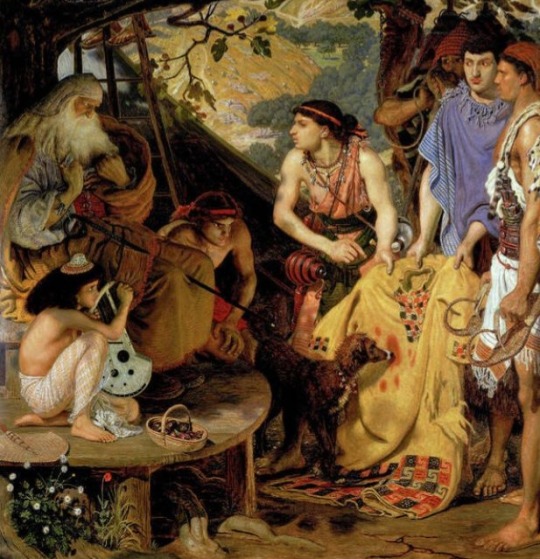
Rebecca also created a WhatsApp group chat, to discuss our project about anything. This was really useful to use, to help each other out, when we couldn't meet up together. This was used alot.
Then later on the week, we made a plan who is going to do what. I'm (Greta) going to the the formal reading and this blog, Rebecca is doing the iconographocal analysis and George is doing the introduction and conclusion, this includes a look into the artist and context.
12th November
George went into the library, to start his part of our presentation. He chose some books about the artist. The photo underneath shows the books he took out.

A week later, we decided to meet up on the weekend, to go up to the Walker Gallery, to take another look at the painting. This is to look at it with fresh pair of eyes.

Then we all talked about the the story, this painting is based on. The Story of Joseph, Genesis 37-50. We had looked up this story on, and to get our reference one.
https://www.biblegateway.com/passage/?search=Genesis%2037-50&version=NLT .
I also looked up at this story on youtube, watching a couple of different videos. This is where I had noticed some differences between. We discussed about as a group, what parts of the story is the painting based on, and what else it references. Then Rebecca made an amazing mind-map breaking down the story.

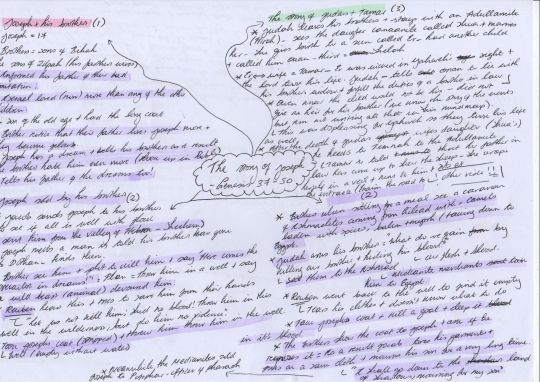
Afterwards, Rebecca took some closer shots of the painting, particularly on things that caught our eye. This is when we noticed details within the painting we didn't see before. For example, the camel, the handle of the crook has a head of a bird, and seashells on the necklace. I made a collage of these close up shots.


26th November.
A week later, we came together at the Liverpool Central Library, to share out notes, and discuss what we have done so far, what we have to moving forwards on with our group work. Also to tie up any loose ends to finish our work this group presentation.

Monday 28th November
Finally, we had the last meet up, before our presentation. Me and Rebecca told George the key aspects of work, so that George can work on his conclusion. Discussed each others work, giving feedback, and a quick run down, in what we are going to say on our presentation.
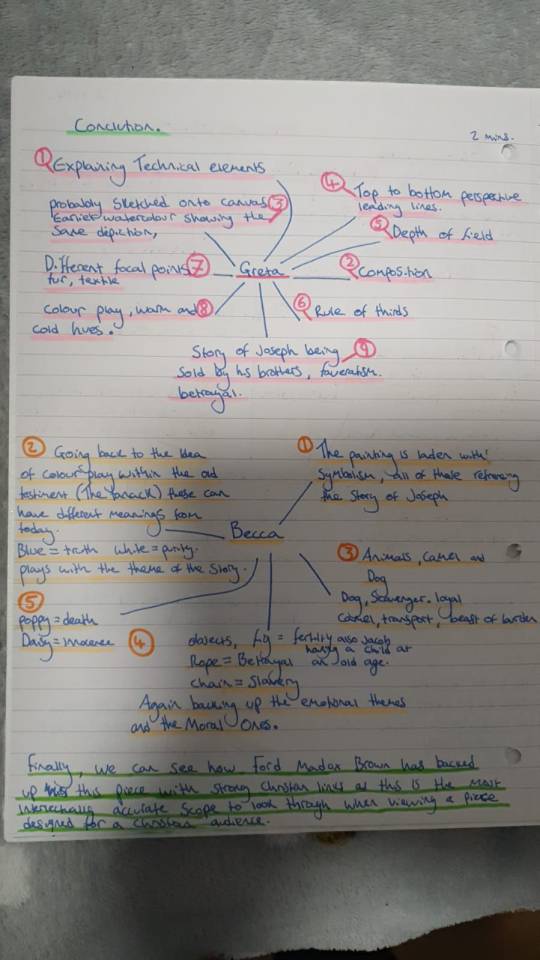
Bibliography
Brown. FM Edited by Virginia Surtess. The Diary of Madox Brown. New Haven and London. Yale University Press, 1981.
Barringer. T Men at work, Art and Labour in Victorian Britain. New Haven and London: Yale University Press, 2005.
Hurault Bernado. 'The Story of Joseph'. Christian Community Bible. Patricia Grogan,Roger Butlans, Adolph Dias. Robert and Bernardine Caminita, Paul Ginivan, Ma, Susana, C, Basmayor, Miriam Cruz, John Ledesma, SDB, Alberto Rossa, CMF. Quezom: Claret Publishing Group. 2016, 120-130.
Murray John. HALL'S, Dictionary of Subjects & Symbols in Art. Norwich: Fletcher & Son Ltd, 1974.
Wilson, Mathew. Symbols in Art. London. Thames & Hudson, Ltd, 2020
Sorry that I have not put the titles in italics, for the Havard referencing system, as I wasn't able to find out how to do this, on tumbler.

8 notes
·
View notes
Text
Winged Wheel Franchise Roster
Winged Wheel- John
G
Augustine Trey
Copley Pheonix
Cossa Sebastian
Forsberg Anton
Hill Adin
Husso Ville
Knight Spencer
Korpisalo Joonas
Larsson Filip
Lennox Tristan
Lyon Alex
Malek Jakub
Merilainen Levi
Nedeljkovic Alex
Skinner Stuart
Svedeback Philip
Tendeck David
Tolopilo Nikita
F
Barzal Mathew
Beaudoin Cole
Becher Ondrej
Beck Owen
Bednarik Kamil
Bennett Sam
Berggren Jonatan
Bourque Mavrik
Brandsegg-Nygard Michael
Buchnevich Pavel
Buyalsky Andrei
Chmelar Jaroslav
Dach Colton
Danielson Nate
DeBrincat Alex
Dellandrea Ty
Dolzhenkov Kirill
Dorofoyev Pavel
Duclair Anthony
Ehlers Nikolaj
Eriksson Ek Joel
Fedotov Ilya
Frost Morgan
Greig Ridly
Gridin Matvei
Halttunen Kasper
Hayton Barrett
Hoglander Nils
Honzek Samuel
Howe Tanner
Huberdeau Jonathan
James Dylan
Jarventie Roby
Kane Patrick
Kaprizov Kirill
Kasper Marco
Kempe Adrian
Koivula Otto
Kotkaniemi Jesperi
Kuzmenko Andrei
L’Heureux Zachary
Larkin Dylan
Leschyshyn Jake
Lindholm Elias
Lombardi Amadeus
Luchanko Jett
Maccelli Matias
Mantha Anthony
Mesar Filip
Nazar Frank
O’Connor Drew
Pekarcik Juraj
Petrovsky Servac
Plante Max
Rasmussen Michael
Raymond Lucas
Reinhart Sam
Ritchie Ryder
Rust Bryan
Saad Brandon
Samoskevich Mackie
Sapovaliv Matyas
Savage Redmond
Schaefer Reid
Sennecke Beckett
Sidorov Yegor
Soderblom Elmer
Sprong Daniel
Steel Sam
Tarasenko Vladimir
Terry Troy
Toffoli Tyler
Torgersson Daniel
Tuch Alex
Tuch Luke
Veleno Joe
Vilardi Gabriel
D
Badinka Dominik
Barron Justin
Edvinsson Simon
Grans Helge
Guenette Maxence
Hanifin Noah
Hirose Akito
Hronek Filip
Jiricek Adam
Joseph Pierre-Olivier
Karki Arttu
Krug Torey
Lindholm Hampus
Livingstone Jake
Marino John
McIsac Jared
O'Rourke Ryan
Pulkkinen Jesse
Pulock Ryan
Samuelsson Mattias
Sandin Pellikka Axel
Schultz Justin
Seider Moritz
Silayev Anton
Spacek David
Svozil Stanislav
Wallinder William
Walman Jake
Weegar Mackenzie
Werenski Zach
2024-25 waivers: 17
0 notes
Text
Basket-case network news producer Jane Craig falls for new reporter Tom Grunnick, a pretty boy who represents the trend towards entertainment news she despises. Aaron Altman, a talented but plain correspondent, carries an unrequited torch for Jane. Sparks fly between the three as the network prepares for big changes, and both the news and Jane must decide between style and substance.
Credits: TheMovieDb.
Film Cast:
Tom Grunick: William Hurt
Aaron Altman: Albert Brooks
Jane Craig: Holly Hunter
Ernie Merriman: Robert Prosky
Jennifer Mack: Lois Chiles
Blair Litton: Joan Cusack
Paul Moore: Peter Hackes
Bobby: Christian Clemenson
Bill Rorich: Jack Nicholson
Martin Klein: Robert Katims
George Wein: Ed Wheeler
Gerald Grunick: Stephen Mendillo
Young Tom: Kimber Shoop
Young Aaron: Dwayne Markee
Young Jane: Gennie James
Jane’s Dad: Leo Burmester
Elli Merriman: Amy Brooks
Anne Merriman: Jane Welch
Clifford Altman: Jonathan Benya
Mercenary: Frank Doubleday
Lila: Sally Knight
Spanish Cameraman: Manuel Alvarez
Guerilla Leader: Luis Valderrama
Guerilla Soldier: Francisco Garcia
General McGuire: Richard Thomsen
Commander: Nat Benchley
Date-Rape Woman: Marita Geraghty
Weekend News Producer: Nicholas D. Blanchet
Makeup Woman: Maura Moynihan
Floor Manager: Chuck Lippman
Paul’s Secretary: Nannette Rickert
Edward Towne: Timothy W. White
Tom’s Soundwoman: Peggy Pridemore
Emily: Emily Crowley
Newsroom Worker: Gerard Ender
Donny: David Long
Chyron Operator: Joshua Billings
Technical Director: Glenn Faigen
Technical Director: Robert Grevemberg Jr.
Control Room Director: Richard Pehle
Weekend News Director: James V. Franco
Assistant Director: Jimmy Mel Green
Assistant Director: Raoul N. Rizik
Technician: Mike Skehan
Audio Visual Engineer: Franklyn L. Bullard
News Theme Writer: Glen Roven
News Theme Writer: Marc Shaiman
Lecture Host: Alex Mathews
Aaron’s Cameraman: Steve Smith
Aaron’s Soundwoman: Martha Smith
Mother in Hall: Cynthia B. Hayes
Young Tough: Dean Nitz
Young Tough: Phil Ugel
Young Tough: Lance Wain
Ellen: Susan Marie Feldman
Tom’s Female Colleague: Jean Bourne Carinci
Cab Driver: M. Fekade-Salassie
Uniformed Cop: Gerald F. Gough
Defense Dept. Spokesman: Robert Rasch
NATO Spokesman: Robert Walsh
Angry Messenger: John Cusack
Film Crew:
Producer: James L. Brooks
Production Design: Charles Rosen
Casting: Ellen Chenoweth
Editor: Richard Marks
Director of Photography: Michael Ballhaus
Unit Production Manager: David V. Lester
Music Editor: Bob Badami
Associate Producer: Kristi Zea
Original Music Composer: Bill Conti
Camera Operator: David M. Dunlap
Co-Producer: Penney Finkelman Cox
Foley Editor: Mark P. Stoeckinger
Costume Design: Molly Maginnis
Executive Producer: Polly Platt
ADR Recordist: Charleen Richards
Associate Producer: Susan Zirinsky
Color Timer: Bob Hagans
Boom Operator: Joseph F. Brennan
Hairstylist: Colleen Callaghan
Foley Editor: Cindy Marty
ADR Voice Casting: Barbara Harris
Still Photographer: Kerry Hayes
First Assistant Editor: Karen I. Stern
Stunt Coordinator: Jery Hewitt
Construction Foreman: Steve Callas
Sound Effects Editor: Patrick Drummond
Supervising Sound Editor: Robert Grieve
Makeup Artist: Carl Fullerton
Property Master: Mark Wade
Sound Re-Recording Mixer: Rick Kline
Sound Re-Recording Mixer: Donald O. Mitchell
Sound Re-Recording Mixer: Kevin O’Connell
Dialogue Editor: Dave Kulczycki
Location Assistant: Peggy Pridemore
Script Supervisor: Mary Bailey
First Assistant Camera: Gábor Kövér
Dialogue Editor: Jacqueline Cristianini
Dialogue Editor: Frank Smathers
ADR Editor: Jessica Gallavan
Construction Coordinator: Bruce J. Gfeller
ADR Editor: Jeff Rosen
Set Decoration: Jane Bogart
Best Boy Electric: Jerry DeBlau
Unit Publicist: Anne Marie Stein
Gaffer: John W. DeBlau
Sound Effects Editor: Linda Whittlesey
Production Coordinator: Cynthia Streit
Sound Mixer: Thomas Causey
Supervising ADR Editor: Beth Bergeron
Second Assistant Director: David Sardi
Negative Cutter: Donah Bassett
Key Grip: Dennis Gamiello
Location Manager: Stuart Neumann
Dolly Grip: John Lowry
First Assistant Director: Yudi Bennett
Se...
#journalism#journalist#love triangle#neurotic#television producer#Top Rated Movies#tv news anchor#USA#washington dc#workaholic
0 notes
Text

anaheimducks.nhl
trevor zegras
john gibson
mason mctavish
bostonbruins.nhl
jeremy swayman
buffalosabres.nhl
tage thompson
carolinahurricanes.nhl
andrei svechnikov
pyotr kochetkov
frederik andersen
chicagoblackhawks.nhl
connor bedard
kevin korchinski
columbusbluejackets.nhl
adam fantilli
dallasstars.nhl
wyatt johnston
matt duchene
tyler seguin
thomas harley
floridapanthers.nhl
carter verhaeghe
matthew tkachuk
mackie samoskevich
newjerseydevils.nhl
jack hughes
luke hughes
seamus casey
dawson mercer
nico hischier
newyorkislanders.nhl
mathew barzal
philadelphiaflyers.nhl
jamie drysdale
torontomapleleafs.nhl
william nylander
matthew knies
simon benoit
joseph woll
utahhockeyclub.nhl
john marino
logan cooley
vancouvercanucks.nhl
quinn hughes
brock boeser
michiganwolverines.ncaa
mark estapa
ethan edwards
nick moldenhauer
teenwolf.tv
liam dunbar
theo raeken
isaac lahey
scott mccall
thehungergames.mov
finnick odair
twisters.mov
scott miller
0 notes
Text
Assigned Reading List for Psychopaths for the Purpose of Evaluation, for More Specialized Integration and Treatment
A Short History of Nearly Everything (Bill Bryson)
The Illustrated A Brief History of Time / The Universe in a Nutshell (Steven Hawking)
Cosmos (Carl Sagan)
Something Deeply Hidden (Sean Carroll)
The Philosophy of Time (Robin Le Poidevin)
The Elegant Universe (Brian Greene)
The End of Everything (Katie Mack)
Sapiens (Yuval Noah Harari)
The Swerve (Steven Greenblatt)
The Hero with a Thousand Faces (Joseph Campbell)
An Indigenous Peoples’ History of the United States (Roxanne Dunbar-Ortiz)
Not “A Nation of Immigrants” (Roxanne Dunbar-Ortiz)
Caste (Isabel Wilkerson)
The Fox Wife (Yangsze Choo)
The Goldfinch (Donna Tartt)
Life After Life (Kate Atkinson)
One Hundred Years of Solitude (Gabriel García Marquez)
tuesdays with Morrie (Mitch Albom)
Ishmael (Daniel Quinn)
The Alchemist (Paulo Coelho)
Braiding Sweetgrass (Robin Wall Kimmerer)
A Little Life (Hanya Yanagihara)
The Tea Girl of Hummingbird Lane (Lisa See)
Haroun and the Sea of Stories (Salman Rushdie)
The Satanic Verses (Salman Rushdie)
The Handmaid’s Tale (Margaret Atwood)
The Testaments (Margaret Atwood)
Infinite Jest (David Foster Wallace)
Lolita (Nabokov)
The End of Alice (A. M. Homes)
Exquisite Corpse (Poppy Z. Brite)
Tampa (Alissa Nutting)
Cows (Mathew Stokoe)
The Call of Cthulhu (H. P. Lovecraft)
Twenty Thousand Leagues Under the Sea (Jules Verne)
White Fang (Jack London)
The Count of Monte Cristo (Alexandre Dumas)
Oliver Twist (Charles Dickens)
Paradise Lost (John Milton)
The Crucible (Arther Miller)
Macbeth (Shakespeare)
Lord of the Flies (William Golding)
To Kill a Mockingbird (Harper Lee)
Don Quixote (Miguel de Cervantes Saavedra)
Frankenstein (Mary Shelley)
Dracula (Bram Stoker)
The Merry Adventures of Robin Hood (Howard Pyle)
The Giving Tree (Shel Silverstein)
The Lorax (Dr. Seuss)
Aesop’s Fables (Aesop)
Grimm’s Fairy Tales (Brothers Grimm)
0 notes
Text
What did Jesus do for Them what did he do for Them gave them a birthday party gave them wings and Halo healed the ones who passed away we gotta say rest in peace to them Eliahna Amyah “Ellie” Garcia 4, June 2012, Louis Joseph, Dauphin of France June 4, 1789, Larry Allen Dick Sr. DEATH 4, June 2003, Sanford M Burns 4, June 1995, William Robert “Big Will” Boatman II 4, June 2016, Lassie 4, June 1940, Dennis Weaver William Dennis Weaver 4, June 1924, Catherine Rosalind Russell 4, June 1907, George III 4, June 1738, Freddy Fender Baldemar Garza Huerta 4, June 1937, SGT Lester Ray Stone Jr.4, June 1947, Samuel Lee Gravely Jr.4, June 1922, Robert “Gorilla Monsoon” Marella c.4, June 1937, Robert Merrill 4, June 1917, Geoffrey Dyson Palmer 4, June 1927, Joseph Francis Scott 4, June 1866, Jerauld Wright 4, June 1898, Gordon Robert Tapp Gordie Tapp 4, June 1922, Stringer Davis 4, June 1899, Nan Leslie Nanette June Leslie 4, June 1926, Clara Blandick Clara Blanchard Dickey 4, June 1876, William Meade Lindsley “Billy” Fiske 4, June 1911, Christopher Morgan 4, June 1808, Constance Mary Katherine “The Apple” Applebee 4, June 1873, Charles E. Laughton 4, June 1846, George Arthur Mathews 4, June 1852, Audrey Marie Hilley Audrey Marie Frazier 4, June 1933, William Halsted 4, June 1794, Gordon Waller 4, June 1945, Carol Andrews Mary Carol Jane Dolan 4, June 1921, John Eager Howard 4, June 1752, Frances Howard Goldwyn 4, June 1903, Edward Russell Hicks 4, June 1895, Morgana King 4, June 1930, Ann Lewis 4, June 1958, Martin Parmer 4, June 1778, Vinton Hayworth 4, June 1906, Priscilla Morrill 4, June 1927, Madame Bolduc Mary Rose-Anne Travers 4, June 1894, Angela Maria “Geli” Raubal 4, June 1908, Howard Culver 4, June 1918, Jeremy Belknap 4, June 1744, William David Elliott 4, June 1921, Dr Robert Francis Furchgott, Nina Vyroubova 4, June 1916, Cardinal Pierre Eyt 4, June 1934, Benjamin Tucker Eames 4, June 1818, Italia Almirante 4, June 1890,
1 note
·
View note
Text
youtube
EMP Attack: The Real Science of Electromagnetic Pulse
PBS Member Stations rely on viewers like you. To support your local station, go to:https://ift.tt/dw9qEVv
Sign Up on Patreon to get access to the Space Time Discord!
https://ift.tt/aHEU4Is
EMPs aren’t science fiction. Real militaries are experimenting on real EMP generators, and as Starfish Prime showed us, space nukes can send powerful EMPs to the surface. So what exactly is an EMP, and how dangerous are they?
Check out the Space Time Merch Store
https://ift.tt/nFxpIHf
Sign up for the mailing list to get episode notifications and hear special announcements!
https://ift.tt/tXcm4Ek
Search the Entire Space Time Library Here: https://ift.tt/ArlzuO5
Hosted by Matt O'Dowd
Written by Matt O'Dowd
Post Production by Leonardo Scholzer, Yago Ballarini & Stephanie Faria
Directed by Andrew Kornhaber
Associate Producer: Bahar Gholipour
Executive Producers: Eric Brown & Andrew Kornhaber
Executive in Charge for PBS: Maribel Lopez
Director of Programming for PBS: Gabrielle Ewing
Assistant Director of Programming for PBS: John Campbell
Spacetime is a production of Kornhaber Brown for PBS Digital Studios.
This program is produced by Kornhaber Brown, which is solely responsible for its content.
© 2024 PBS. All rights reserved.
End Credits Music by J.R.S. Schattenberg: https://www.youtube.com/user/MultiDroideka
Space Time Was Made Possible In Part By:
Big Bang Sponsors
John Sronce
Bryce Fort
Peter Barrett
David Neumann
Alexander Tamas
Morgan Hough
Juan Benet
Vinnie Falco
Mark Rosenthal
Quasar Sponsors
Glenn Sugden
Alex Kern
Ethan Cohen
Stephen Wilcox
Mark Heising
Hypernova Sponsors
Chris Webb
David Giltinan
Ivari Tölp
Kenneth See
Gregory Forfa
drollere
Bradley Voorhees
Scott Gorlick
Paul Stehr-Green
Ben Delo
Scott Gray
Антон Кочков
Robert Ilardi
John R. Slavik
Mathew
Donal Botkin
Edmund Fokschaner
chuck zegar
Jordan Young
Daniel Muzquiz
Gamma Ray Burst Sponsors
Anthony Crossland
Grace Seraph
Frank Plessers
Max Paladino
Stephen Saslow
Robert DeChellis
Tomaz Lovsin
Anthony Leon
Leonardo Schulthais Senna
Lori Ferris
Dennis Van Hoof
Koen Wilde
Nicolas Katsantonis
gmmiddleton
Joe Pavlovic
Justin Lloyd
Chuck Lukaszewski
Andrea Galvagni
Jerry Thomas
Nikhil Sharma
John Anderson
Bradley Ulis
Craig Falls
Kane Holbrook
Ross Story
teng guo
Harsh Khandhadia
Michael Lev
Terje Vold
James Trimmier
Jeremy Soller
Paul Wood
Joe Moreira
Kent Durham
jim bartosh
Ramon Nogueira
John H. Austin, Jr.
Faraz Khan
Almog Cohen
Daniel Jennings
Russ Creech
Jeremy Reed
David Johnston
Michael Barton
Isaac Suttell
Oliver Flanagan
Bleys Goodson
Mark Delagasse
Mark Daniel Cohen
Shane Calimlim
Tybie Fitzhugh
Eric Kiebler
Craig Stonaha
Frederic Simon
John Robinson
Jim Hudson
David Barnholdt
John Funai
Adrien Molyneux
Bradley Jenkins
Amy Hickman
Vlad Shipulin
Thomas Dougherty
King Zeckendorff
Dan Warren
Joseph Salomone
Patrick Sutton
Julien Dubois
via YouTube https://www.youtube.com/watch?v=ZMjo_UY8vEM
0 notes
Text
Cine a inventat de fapt becul cu incandescenta?
A fost Thomas Edison sau altcineva?
De la becul cu incandescenta la becul led de azi.
1.CINE A INVENTAT BECUL SI CAND?
2.PRIMELE CERCETARI SI DEZVOLTARI
3.PRIMA LAMPA ELECTRICA
4.PRIMUL BEC SCUMP
5.IN CAUTAREA BECULUI IEFTIN
6.O CONCURENTA BENEFICA: JOSEPH SWAN VS. THOMAS EDISON
7.PRIMUL BEC INCANDESCENT PRACTIC
8.CARE ESTE BECUL CU CEA MAI LUNGA VIATA?
9.UTILIZAREA BECULUI IN MASA
10.BECUL CU FILAMENT DIN WOLFRAM
11.ELIMINAREA TREPTATA A BECURILOR CLASICE
12.BECURILE LED
13.INFORMATII INTERESANTE DESPRE BEC
1.CINE A INVENTAT BECUL SI CAND?
Desi Thomas Edison e creditat ca si omul care a inventat becul asa cum sustin majoritatea, cativa alti inventatori au pavat drumul inaintea sa. Dupa cum veti afla în curand, raspunsul la aceasta enigma este mai puțin clar. Depinde și de ceea ce ați considera un bec „adevarat”. Dar, la fel ca multe inventii de-a lungul timpului, produsul final este munca cumulativa a multor inventatori de-a lungul istoriei, același lucru este valabil și pentru bec. lampa antipanica
Azi vom face un tur rapid prin istoria becului și ne vom opri la cativa dintre jucatorii cheie.
Bec Edison - obiectul din imaginea de mai sus face parte din colecția protejată de obiecte a Institutului Franklin
Faimosul american Edison nu este singurul contributor la dezvoltarea acestei tehnologii extraordinare, inaintea sa sunt creditate merite lui Ebenezer Kinnersley, Alessandro Volta, Humphry Davy, James Bowman Lindsay, Marcellin Jobard, Warren de la Rue,John W. Starr, Moses Gerrish Farmer, Alexander Lodygin, Henry Woodward, Mathew Evans, si in cele din urma lui Joseph Wilson Swan. iluminat antipanica
2.PRIMELE CERCETARI SI DEZVOLTARI
Istoria becului incepe cu mult inainte ca Edison sa pantenteze primul sau bec comercial in 1879.
In anul 1761, inventatorul englez Ebenezer Kinnersley oferea demonstratii in care incalzea conductoare pe care le aducea la incandescenta. In anul 1800, inventatorul italian Alessandro Volta a dezvoltat prima metoda practica de generarea a electricitatii, si anume pila voltaica. Realizata din discuri succesive de zinc si cupru, intercalate cu straturi de carton inmuiate in apa sarata, pila conducea electricitatea atunci cand un fir de cupru era conectat la fiecare capat. Firul de cupru stralucitor al lui Volta este oficial considerat precursorul bateriei, dar totodata este considerat si ca manifestarea timpurie a iluminatului incandescent. iluminat panica
Potrivit lui Harold Schobert, pila voltaica "a permis oamenilor de stiinta sa experimenteze curentul electric sub conditii controlate". La scurt timp dupa ce Volta si-a prezentat descoperirea sa pentru o sursa continua de electricitate Societatii Regale din Londra, Davy Humphry produce prima lampa electrica din lume conectand pila electrica la electrozi de carbune. iluminat pentru continuarea lucrului
3.PRIMA LAMPA ELECTRICA
Inventia lui Davy din 1802 a fost cunoscuta ca lampa cu arc electric, numita dupa arcul luminos emis intre cei doi electrozi de carbon, potrivit scrierilor din "The Life of Sir Humphrey Davy" (HardPress Publishing, 2016)
O schita cu Humphry lucrand la un experiment cu alcaline
Chiar daca lampa lui Davy era o imbunatatire sigura la pila lui Volta, nu era inca suficient de practica ca si sursa de lumina. Aceasta lampa rudimentara ardea repede si era mult prea luminoasa pentru uzul in casa sau intr-un spatiu de munca. Cu toate acestea alte experimente ale lui Davy au condus catre lampa de siguranta pentru mineri, iluminatul strazilor in Paris si alte orase europene. Principiul din spatele lampii cu arc electric al lui Humphry Davy a fost folosit in dezvoltarea multor lampi electrice si becuri in anii 1800. iluminat de siguranta pentru evacuare normativ
In 1835, James Bowman Lindsay a demonstrat o lumina electrica constanta la o intalnire publica din Dundee, Scoția. El a declarat ca poate „sa citeasca o carte la o distanta de un picior si jumatate”. Cu toate acestea, el nu a mai dezvoltat lampa electrica.
4.PRIMUL BEC SCUMP
In 1840, savantul britanic Warren de la Rue a dezvoltat o lampa de lumina ce folosea un filament elicoidal de platina in loc de cupru, dar costul ridicat al platinii a impiedicat lampa sa aiba un succes comercial
In 1848, englezul William Staite a imbunatatit longevitatea lampii cu arc conventional dezvoltand un mecanism de ceas care regla miscarea electrozilor de carbon care se erodau atata de repede. Dra costul bateriilor uzate sa alimenteze lampa lui Staite limitau deasemenea o posibila aplicatie practica. Dupa cum puteti vedea inventarea becului nu tine cont doar de inventarea sa, ci si de posibilitatile de alimentare cu energie electrica de la acea vreme. kit emergenta lampi led 2h
In 1859, Moses G. Farmer a construit un bec electric cu incandescenta folosind un filament de platina. Thomas Edison a vazut mai tarziu unul dintre aceste becuri intr-un magazin din Boston si i-a cerut lui Farmer sfaturi cu privire la afacerea cu lumina electrica.
5.IN CAUTAREA BECULUI IEFTIN
In 1872, rusul Alexander Lodygin a inventat un bec cu incandescenta si a obtinut un brevet rusesc în 1874. A folosit doua tije de carbon subtiri intr-un recipient de sticla, inchis ermetic si umplut cu azot. Mai tarziu a locuit in SUA, si-a schimbat numele in Alexander de Lodyguine si a obtinut brevete pentru lampi cu incandescenta care aveau filamente de crom, iridiu, rodiu, ruteniu, osmiu, molibden și wolfram, iar un bec care folosea un filament de molibden a fost demonstrat la targul mondial din 1900 de la Paris.
Timbru rusesc din 1952 cu Alexander Lodigyn
6.O CONCURENTA BENEFICA: JOSEPH SWAN VS. THOMAS EDISON
In 1850, chimistul englez Joseph Swan nascut in Sunderland a inceput incercarile pentru realizarea unei lampi electrice mult mai economice, si pana in 1860 a dezvoltat un bec care utiliza filamente din hartie carbonizata in locul filamentelor de platina. Swan a primit un patent in U.K. in 1878, si in februarie 1879 a facut demonstratii publice ale acestei descoperiri stiintifice folosind lampi experimentale.
Asemenea interpretarilor anterioare ale becului, filamentele lui Swan au fost plasate într-un tub vidat pentru a minimiza expunerea lor la oxigen, prelungindu-le durata de viata. Din nefericire pentru Swan, pompele de vid nu erau foarte eficiente atunci, iar prototipul nu funcționa suficient de bine pentru utilizarea de zi cu zi.
Edison a realizat ca problema lui Swan era filamentul. Un filament subtire cu rezistenta electrica mare ar face practica lampa fiindca ar necesita un curent mic pentru a o face sa straluceasca. El a facut o demonstratie a becului sau folosind un filament de platina intr-un tub de sticla vidat in decembrie 1879 in New Jersey.
Swan a preluat imbunatatirile folosindu-le in propriul bec si a fondat o firma de iluminat electric in Anglia.
Edison l-a dat in judecata pentru incalcarea brevetelor, dar brevetul lui Swan a fost puternic aparat, cel putin in U.K. Cei doi inventatori si-au unit in cele din urma fortele si au format compania Edison-Swan United, care a devenit una dintre cele mai mari producatoare de becuri din lume.
Compania Edison si Swan - sursa: Wikimedia Commons
7.PRIMUL BEC INCANDESCENT PRACTIC
Unde Edison și-a depasit concurenta a fost în dezvoltarea unui bec practic si ieftin. Edison și echipa sa de cercetatori au testat peste 3.000 de modele de becuri între 1878 și 1880. Deoarece designul său a avut atât de mult succes, a dominat efectiv piața și a depășit toate celelalte versiuni.
In noiembrie 1879, Edison a depus un brevet pentru o lampa electrica cu filament de carbon, conform Arhivelor Naționale Amerciane. Brevetul a enumerat mai multe materiale care ar putea fi folosite pentru filament, inclusiv bumbac, in si lemn. Edison si-a petrecut anul urmator gasind filamentul perfect pentru noul sau bec, testand peste 6.000 de plante pentru a determina ce material ar arde cel mai mult. Edison a recunoscut ca munca a fost plictisitoare și foarte solicitanta, în special pentru lucratorii sai care ajutau la experimente. El a recunoscut intotdeauna importanta muncii si a hotararii.
La cateva luni dupa acordarea brevetului din 1879, Edison si echipa sa au descoperit ca un filament de bambus carbonizat ar putea arde mai mult de 1.200 de ore, potrivit Muzeului Edison. Bambusul a fost folosit pentru filamentele becurilor lui Edison pana cand a început sa fie inlocuit cu materiale cu o durata mai lunga de viata in anii 1880 - 1900.
8.CARE ESTE BECUL CU CEA MAI LUNGA VIATA?
In 1882, Lewis Howard Latimer, unul dintre cercetatorii lui Edison, a brevetat o modalitate mai eficienta de fabricare a filamentelor de carbon. Si în 1903, Willis R. Whitney a inventat un tratament pentru aceste filamente care le-a permis sa arda stralucitor fara a innegri interiorul becurilor de sticla, potrivit Institutului Smithsonian.
9.UTILIZAREA BECULUI IN MASA
Incepe electrificarea natiei cu 3 firme mari competitoare Edison, Thomson-Houston si Westinhouse Electric pentru suprematia in afacerea lucrativa de a construi retele electrice, incluzand statii generatoare, statii de transformare, sisteme de distributie, sisteme de iluminat. Edison era un sustinator al sistemului de curent continuu DC, in timp ce Thomson si Westinghouse sustinea sistemul de curent alternativ AC. Pana in 1890 Edison isi da seama ca retelele de curent alternativ erau o solutie superioara, asadar in 1891 Edison incearca sa obtina un imprumut de la bancherul JP Morgan pentru a cumpara cele 2 companii si patentele lor de AC.
In schimb, in 1892, Morgan a achizitionat atat Edison Electric Co., cat si Thompson-Houston Co. si le-a fuzionat sub numele de General Electric Co. un conglomerat american, a doua companie din Statele Unite Ale Americii ca valoare de piata dupa ExxonMObil si a treia din lume in anul 2008.
0 notes